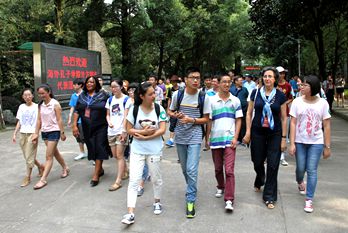Measures shine financial light on Zhejiang

A bank employee helps a customer at a service station in Huzhou, Zhejiang province, in August. WENG XINYANG/XINHUA
Common prosperity's demonstration zone to inspire other regions nationwide
New financial measures to be implemented in Zhejiang province will not only accelerate the region's attempt to pioneer common prosperity, but also set an example for other parts of the country, experts said on Monday.
Their remarks emerged after a guideline unveiled by the People's Bank of China and other authorities on Friday delineated how the financial system should drive the pursuit of Zhejiang to build itself into a model of common prosperity.
Friday's guideline introduced dozens of specific measures. It also upheld the principles of optimizing financial resource allocation to promote high-quality development and resolving disparities among different regions and income gaps between different groups.
Wang Peng, an associate professor with Hillhouse Academy, which is part of the Renmin University of China, said the new financial measures will help Zhejiang to build itself into a demonstration zone of common prosperity. They will vitalize key industries in the province and help lift people's incomes, Wang said.
"Financial support ranging from making direct and indirect financing more accessible to facilitating the use of foreign exchange will boost key regional industries like the internet and help nurture emerging industries, thus expanding the sources of people's income," Wang said.
Friday's guideline pledged efforts to enhance financial support for technological innovation, with a focus on the three key industries of internet plus, life and health, and new materials.
Measures will be taken to encourage banks to deepen cooperation with investment institutions and explore diversified services to support technological innovation. Efforts will be made to encourage mainland stock exchanges to work with authorities concerned in the province to establish a mechanism that can aid local companies to go public, the guideline said.
Apart from boosting innovation-driven economic development, the guideline also featured measures to lift incomes of less-advantaged groups and strengthen public services.
It vowed to incorporate qualified affordable housing projects into the funding scope of local government special bonds and beef up financial services to self-employed businesses, migrant workers, rural residents and other segments of the population.
The guideline said the province will expand the application of "loan code", by which small businesses can apply for loans using their mobile phones, encourage the use of big data in insurance claims in the agricultural sector and support qualified areas to launch digital renminbi pilots.
Zheng Lei, deputy head of International New Economic Research Institute, lauded the guideline's focus on leveraging the region's advantages in digital industries to improve and personalize financial support for smaller businesses and rural areas.
The efforts to be made in Zhejiang, which is home to many of the country's top internet companies like Alibaba, could help set an example for the whole nation to empower inclusive finance with digital technologies, Zheng said.
Chen Jia, a researcher with the Renmin University of China's International Monetary Institute, said practices to be implemented in Zhejiang under the guideline will have the potential to help China draw up a roadmap to drive common prosperity, using the combination of financial services and digital technologies.
In addition, the guideline released measures to boost cross-border finance and expand financial opening-up, including promoting pilots to facilitate foreign exchange payments and cross-border private equity investments.
Last year, China announced it will build Zhejiang into a demonstration zone for common prosperity, aiming to generally realize common prosperity in the region by 2035, when its per capita GDP and the income of urban and rural residents are expected to be on a par with those of developed economies.

 City brand logo - fist-and-palm salute
City brand logo - fist-and-palm salute Confucianism on campus
Confucianism on campus The culture of the academy
The culture of the academy